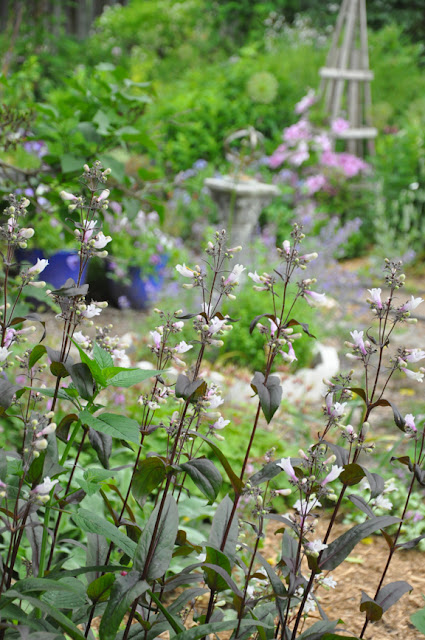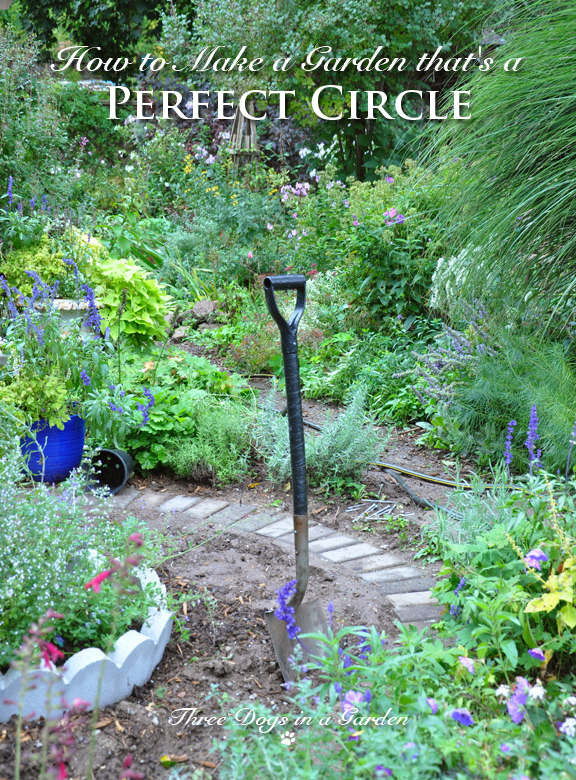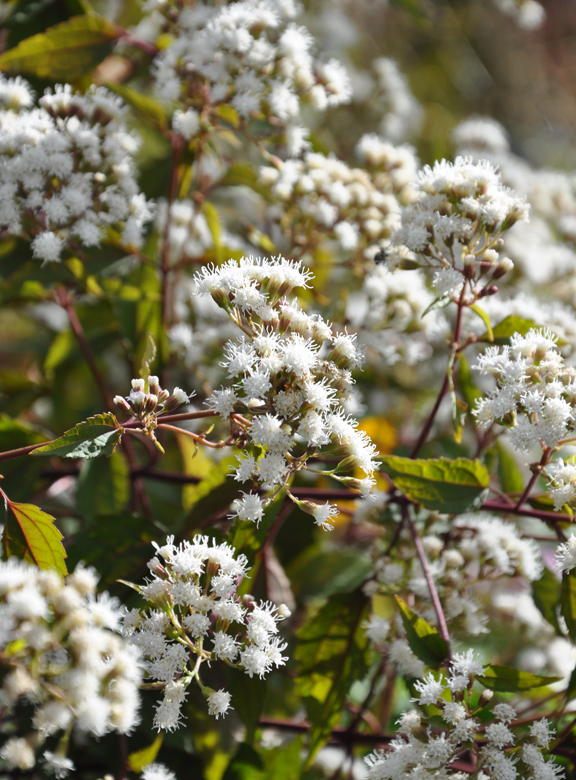But where to plant them?
In a flash of inspiration, I convinced my husband to dismantle an old workbench he no longer used and make me a raised garden bed for the tomatoes. The workbench was rough pine, which isn't the best choice for a raised bed (rot-resistant hardwoods like cedar and redwood are generally recommended), but hey, it meant a second life for the unused workbench.
Last week I cut all the invasive plants right to the ground and then my husband rototilled the area. This week I have been raking the ground level and covering it with a layer of cardboard and mulch. It will have to rest for the remainder of the season to make sure all the invasive plants under the cardboard don't come back next spring.
The markings on the workbench are still visible. I told my husband I thought the measurements and illustrations were a nice bit of industrial chic.
What are my plans for the final frontier?
It will be a spot to grow tomatoes or other veggies, a permanent home for my two cold frames and we hope to build a DIY greenhouse. There will also be a little courtyard with a small metal table and chairs. So stay tuned for pictures of these new projects.
Most of the hard work had been done last fall. Our soil is heavy clay, so the first thing I had to do was improve the drainage. Thyme is a Mediterranean herb that loves free draining, nutrient-poor soil.
I planted plugs of thyme last September and again this spring. They're filling in slowly, but in the meantime, the weeds have discovered the open ground. When I spotted a bulk package of thyme seeds at Walmart, I thought I would give growing plants from seed a try.
The package instructions for sowing a thyme lawn are fairly simple. The ground needs to be raked to loosen the soil and then the seeds scattered over the prepared area (organic vermiculite is mixed with the fine seeds to aid even distribution). Finally, the seeds need to be raked in and the area watered with a gentle spray.
The package of bulk seeds gives me enough for a second application if need be. Hopefully, it will fill in to make a dense carpet like this!
Across from the bench and the sundial is a mature lilac. It's an odd spot that gets a full range of light conditions; sun on the outer rim, part-sun and full shade. Hostas would have worked well, but I wanted to do something a little different, so a created a flowerbed devoted largely to hardy geraniums.
I moved these Lupins in the early spring and wasn't sure they'd still flower. As you can see, they look lovely with the Catmint 'Walker's Low' and the Penstemon 'Husker Red'.
Astrantia major rubra has lovely starry flowers that are rosy-red. Average to moist soil. Full sun to partial shade. Height: 75-90 cm (29-35 inches) Spread: 45-60 (18-23 inches). USDA zones:3-9.
A few plants that might inspire shade gardeners. These foxgloves are self-sown and very willful. They like to pop up on the perimeter but never inside my raised beds.
We've been super busy (hence the lack of blog posts!). The pond is all dug out, but the stream and waterfall still need to be addressed. The days never seem to be long enough to get everything done.
So I dug out most of the clay and mixed in fine gravel and sand to what remained.
Thyme plugs that I got on sale at a grocery store garden centre.
The package of bulk thyme seeds from McKenzie Seeds.
The package instructions for sowing a thyme lawn are fairly simple. The ground needs to be raked to loosen the soil and then the seeds scattered over the prepared area (organic vermiculite is mixed with the fine seeds to aid even distribution). Finally, the seeds need to be raked in and the area watered with a gentle spray.
Across from the bench and the sundial is a mature lilac. It's an odd spot that gets a full range of light conditions; sun on the outer rim, part-sun and full shade. Hostas would have worked well, but I wanted to do something a little different, so a created a flowerbed devoted largely to hardy geraniums.
Geranium 'Aunty Marge' is one of my favourites. Too bad it is not sold commercially anymore.
The area near the lilac as it looks now.
I want to show you some of the other things that are blooming right now. In the front garden, the white Gas Plant is finishing while the peonies and roses are in full flower.
The view out the front door.
One of my birdbath container plantings.
Penstemon 'Husker Red'
The Euonymus arch just inside the back gate has grown so heavy it has snapped the wooden support. We have yet to figure out what to do about it. Right now, it's being held together with two metal poles and some rough pieces of lumber.
I moved these Lupins in the early spring and wasn't sure they'd still flower. As you can see, they look lovely with the Catmint 'Walker's Low' and the Penstemon 'Husker Red'.
'Cherokee' Clematis which is part of the Boulevard series of patio clematis. It only grows 4-5 ft.
My favourite Amsonia
Amsonia 'Blue Ice' has dark blue buds that open into soft lavender-blue flowers. This is a nice compact plant that looks great at the front of a flowerbed. It is slow to establish but long-lived. Full sun. Height: 35-40 cm (14-16 inches) Spread: 45-60 (14-18 inches). USDA zones:4-9.
Astrantia likes moist soil, so I have struggled to get it established.
It's liking all the rain we had this spring!
Phlomis tuberosa 'Amazone' When not in flower, this plant makes a large mound of coarse green leaves. Flowers shoot skyward on these incredible reddish colored stems. Once finished flowering, spent flowers continue to add architectural interest well into winter. Normal or sandy soil that is on the dry side is best for this plant. Full sun. Height: 90-120 cm (35-47 inches), Spread: 45-60 cm (18-23 inches). USDA Zones: 2-9.
I am showing you this picture so you can place the next image in the context of the whole garden. The Beauty Bush is just stunning at this time of year!
Beauty Bush, Kolkwitzia has pale pink flowers and a fountain shape with branches that hang in long, sweeping arcs. Full sun. Height: 8-10', Spread: 8-10' USDA Zones: 5-9.
I am trying to include a little more peach in the garden.
Rose, Rosa 'At Last' from Proven Winners® has popsicle-peach flowers that are nicely fragrant. The foliage is glossy and disease-resistant. Repeat flowering without the need to deadhead. Full sun. Height: 76-91 cm (30-36 inches) Spread: 76-91 (30-36 inches). USDA zones:5-9.
A few plants that might inspire shade gardeners. These foxgloves are self-sown and very willful. They like to pop up on the perimeter but never inside my raised beds.
Lady Fern, Athyrium filix-femina' Lady-in-Red'
Lady Fern, Athyrium filix-femina' Lady-in-Red' has light green foliage with reddish stems. Rich, evenly moist, well-drained soil is key to growing this fern successfully. Part-shade to full shade. Height: 45-60 cm (18-24 inches) Spread: 45-60 (18-24 inches). USDA zones:4-8.
Love this hosta!
Hosta 'Snake Eyes' has medium green leaves with a light green centre framed with a creamy-white edge. The flowers are lavender. Part-shade to full shade. Height: 55-60 cm (21-23 inches), Spread: 110-120 cm (43-47 inches). USDA zones: 2-9.
Aruncus 'Misty Lace' has feathery-white flowers and fern-like foliage. It is a more compact form of Goat's Beard that would work well in a small to medium-sized garden. Height: 60-75 cm (23-29 inches), Spread: 45-60 cm (18-23 inches). USDA zones: 3-9.





























































